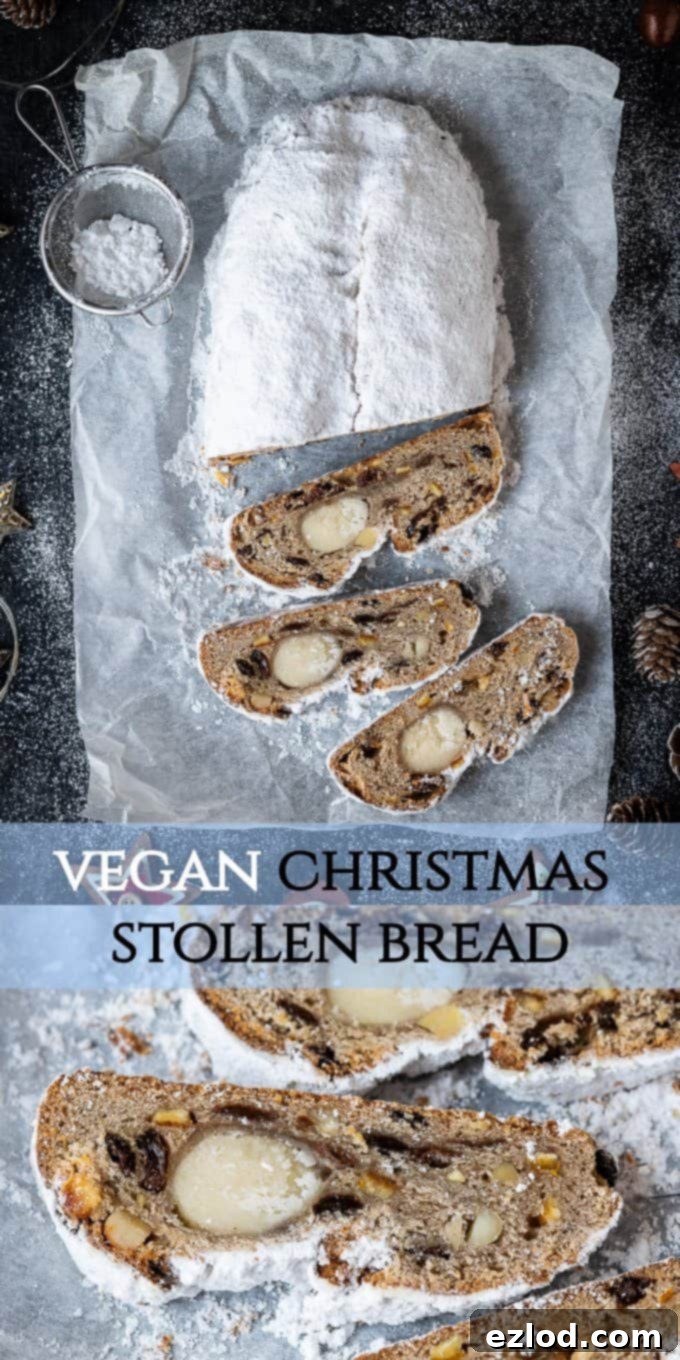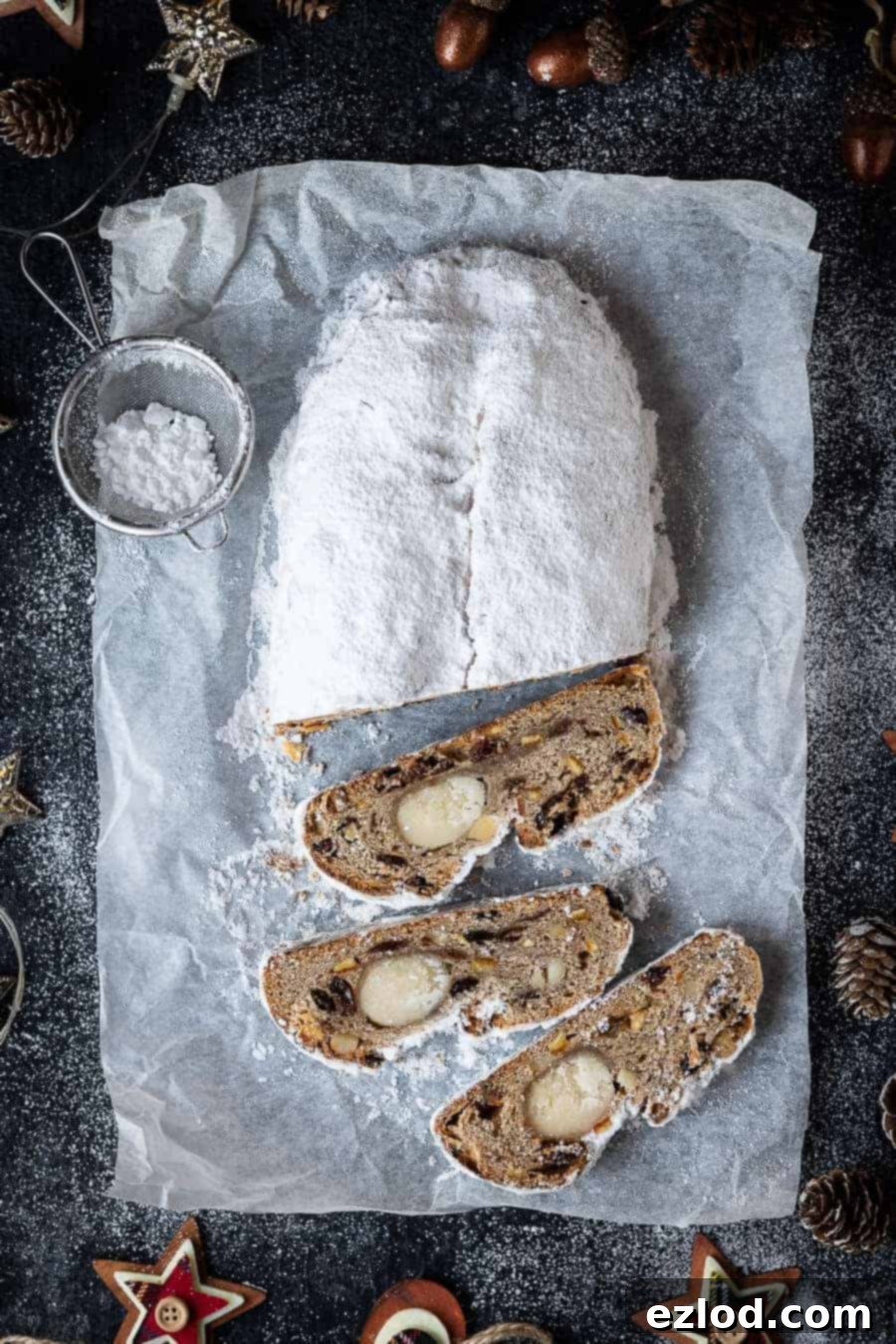The Ultimate Vegan Stollen Recipe: A Festive German Christmas Bread
Vegan stollen – this vegan version of a traditional German Dresden Stollen is a wonderful treat for Christmas. You can eat it right away or make it in advance and let it mature for a couple of weeks before serving for the best flavour.
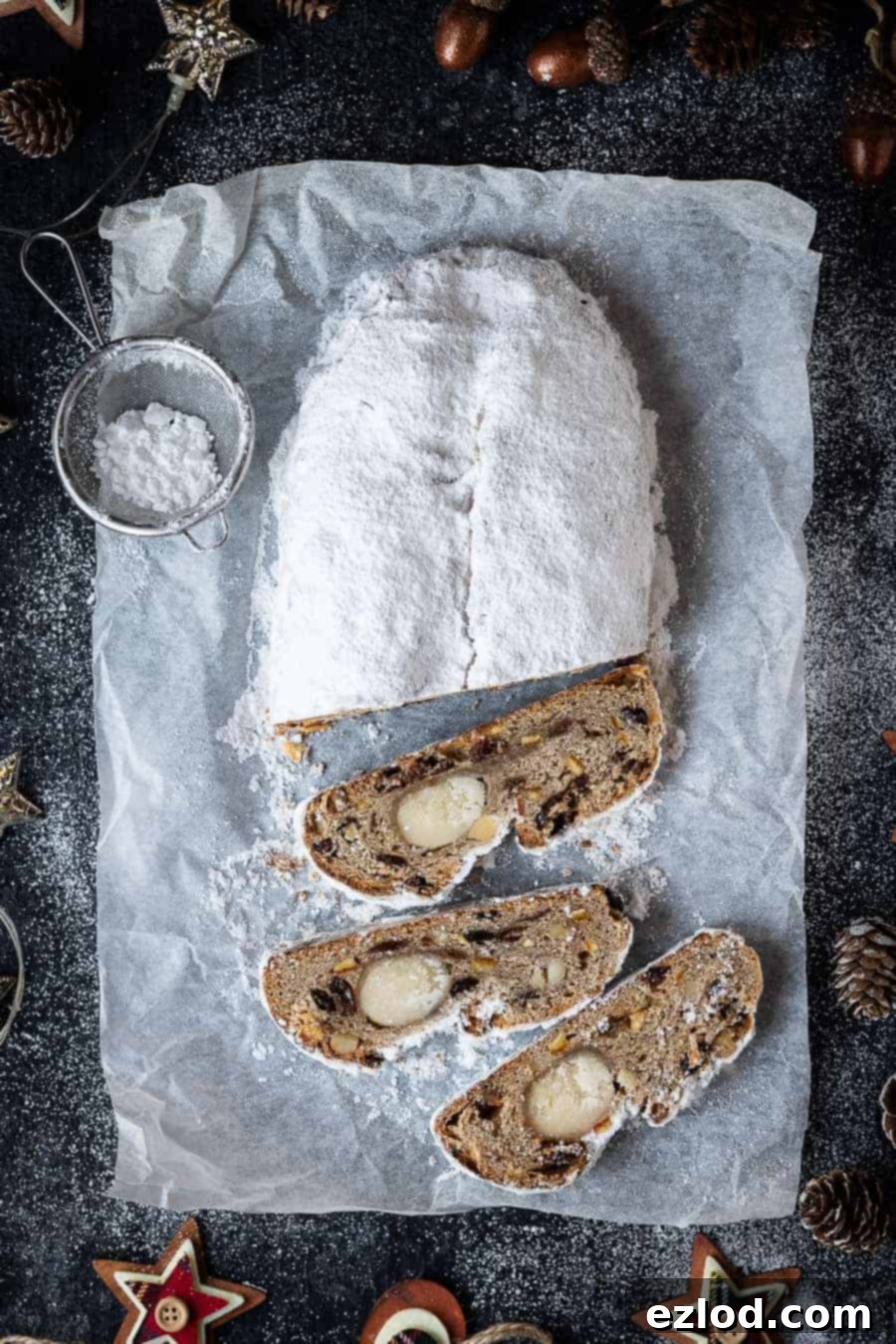
As the festive season approaches, there’s a certain magic in the air, often accompanied by the irresistible aroma of traditional Christmas baking. Among the many cherished holiday treats, German Stollen holds a special place in the hearts of many – and mine is no exception! This dense, wonderfully cake-like, fruity, and often marzipan-filled bread is an absolute delight. For those embracing a plant-based lifestyle, the good news is that enjoying this classic doesn’t mean compromising on flavour or tradition. This vegan stollen recipe offers a magnificent, dairy-free, and eggless rendition of the beloved German Dresden Stollen, making it a truly wonderful treat for Christmas.
While readily available vegan stollen options exist in supermarkets, there’s an unparalleled satisfaction that comes from creating this festive bread from scratch. The homemade version allows for careful selection of ingredients, ensuring a depth of flavour and a perfect texture that store-bought varieties often can’t match. It’s a culinary journey that rewards patience with an exceptional result.
Developing this recipe took me through four attempts to achieve the ideal texture and taste, but the final outcome is truly worth every moment spent. The result is a perfectly dense, moist, and incredibly flavourful loaf, generously studded with rum-soaked fruits and featuring a delightful marzipan core. This isn’t just a recipe; it’s an invitation to experience the rich, aromatic traditions of German Christmas baking, made entirely plant-based.
What is Traditional Stollen?
Stollen is a quintessential German Christmas bread, steeped in history and tradition. Originating from Dresden, it’s known for its distinctive shape, resembling a swaddled baby Jesus, hence its association with Christmas. Unlike many conventional breads, stollen is intentionally dense and rich, loaded with a high fat content that contributes to its signature texture – almost more like a fruitcake than a typical loaf of bread. This richness isn’t just for flavour; it’s also key to its excellent keeping qualities, allowing the bread to mature and develop deeper flavours over several weeks without drying out.
Traditional stollen is typically made with butter, eggs, and milk, along with dried fruits like raisins, candied citrus peel, nuts, and a blend of warm spices such as cinnamon, cardamom, and nutmeg. A crucial element is often a log of marzipan baked into the center, adding a sweet, almondy surprise to every slice. After baking, it’s generously brushed with melted butter and dusted with powdered sugar, which helps to preserve it and gives it its iconic snowy appearance.
Embracing the Vegan Challenge: Crafting the Perfect Plant-Based Stollen
Creating a vegan version of such a rich and historically significant bread presents a unique challenge: how to replicate that signature density, moisture, and profound flavour without dairy or eggs. My goal was not simply to make a passable vegan stollen, but to craft one that truly stands shoulder to shoulder with its traditional counterpart. This involved extensive experimentation, particularly with the fat content and rising times, to ensure the dough achieved that characteristic ‘cakey’ bread texture rather than being too light or crumbly.
The journey culminated in a recipe that perfectly balances tradition with plant-based innovation. We achieve the high fat content necessary for a moist, long-keeping stollen by using a high-quality vegan block butter, which mimics the richness of dairy butter far better than spreadable alternatives. The lengthy fermentation process further develops the flavour and structure, resulting in a bread that is not only delicious straight from the oven but also improves wonderfully with age.
Why a Three-Day Process is Essential for Authentic Vegan Stollen
Let’s be upfront: this recipe is a true labour of love, but the extraordinary results make every moment worthwhile. Don’t be deterred by the three-day timeline; the vast majority of this time is inactive, dedicated to allowing the dough to slowly ferment and develop its complex flavour profile. This extended process is not merely a suggestion but a critical step, especially for an enriched dough like stollen.
Unlike lean bread doughs that rise quickly, heavily enriched doughs, packed with fat and sugar, require significantly more time to ferment. This slow rise is crucial for several reasons: it allows the yeast to work thoroughly, creating a fine crumb structure; it develops a much deeper, more nuanced flavour; and it contributes to the stollen’s characteristic dense yet moist texture. I experimented with shorter rising times, but the loaves turned out disappointingly heavy and overly dense, lacking the desired balance. The long, patient rise is therefore absolutely necessary for achieving the perfect vegan stollen – one that is rich, tender, and keeps beautifully.
The good news is that while the process spans three days, the active hands-on time is surprisingly minimal. Most of the work involves mixing, a bit of kneading, and then patiently waiting for the dough to do its magic. Plus, this recipe yields two generous loaves of stollen, making the effort doubly rewarding – one for immediate enjoyment and one for maturing or gifting!
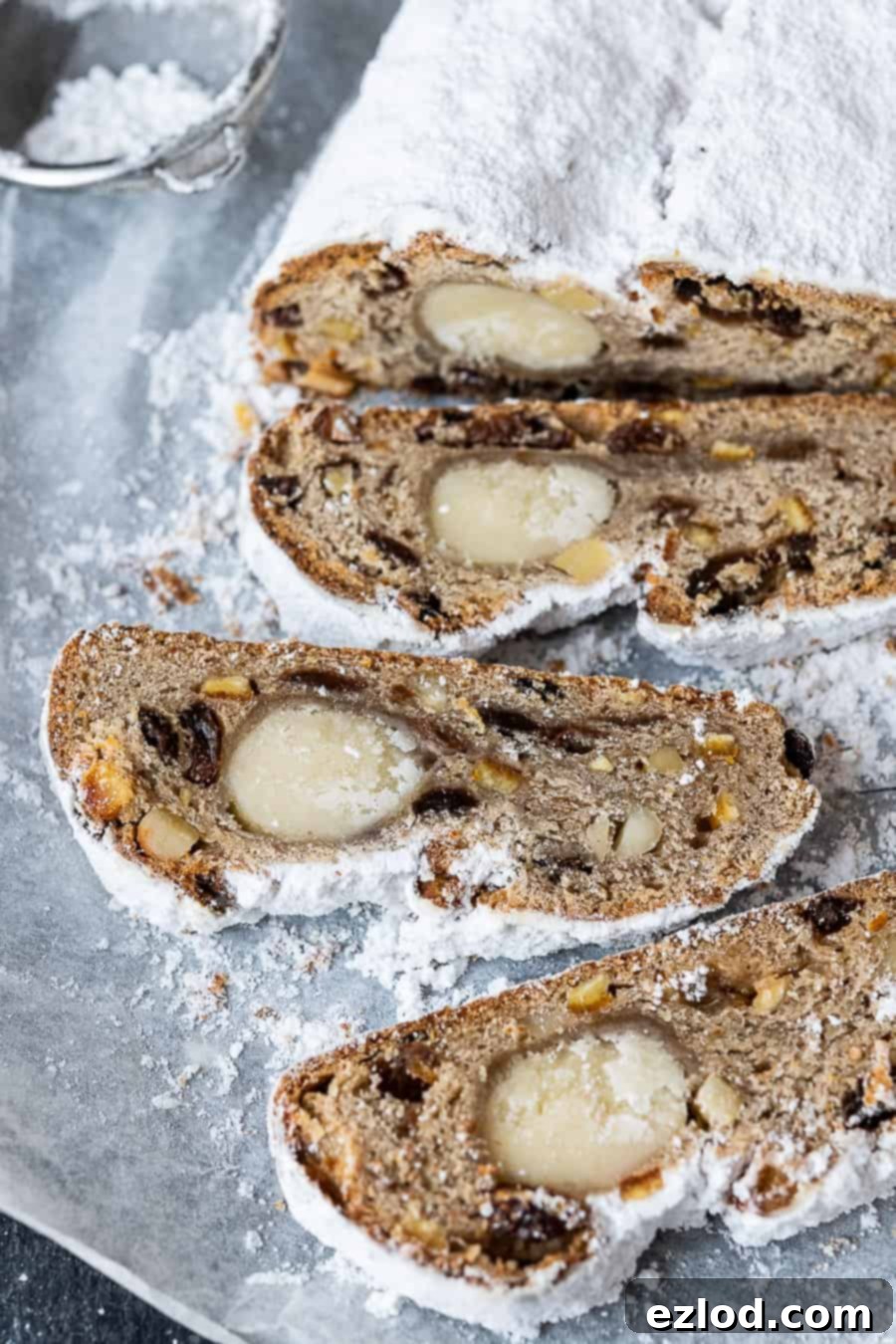
How to Master Your Homemade Vegan Stollen
Crafting this exquisite vegan stollen requires attention to detail and patience, but the process is incredibly rewarding. To ensure the best possible outcome, it’s vital to follow the recipe steps closely, especially when it comes to measurements and timings. A digital scale for gram measurements is highly recommended, as cup conversions can be notoriously inaccurate in baking and may affect the final texture and consistency of your stollen.
This stollen is made over three days, allowing ample time for flavours to meld and the dough to develop properly. Here’s a detailed breakdown of each stage:
Day 1: Preparing the Fruit Mixture
On the evening of the first day, begin by combining the raisins, candied mixed peel, and rum in a bowl. Give this mixture a thorough stir to ensure all the fruits are coated. Cover the bowl and allow it to soak overnight. This crucial step not only infuses the fruits with the delightful aroma and flavour of rum but also plumps them up, ensuring they remain moist and juicy throughout the baking process.
Day 2: Crafting the Enriched Dough and First Rise
The second day is dedicated to preparing the rich stollen dough. Start by stirring the chopped almonds into your rum-soaked fruit mixture; this allows the nuts to absorb some of the residual rum flavour.
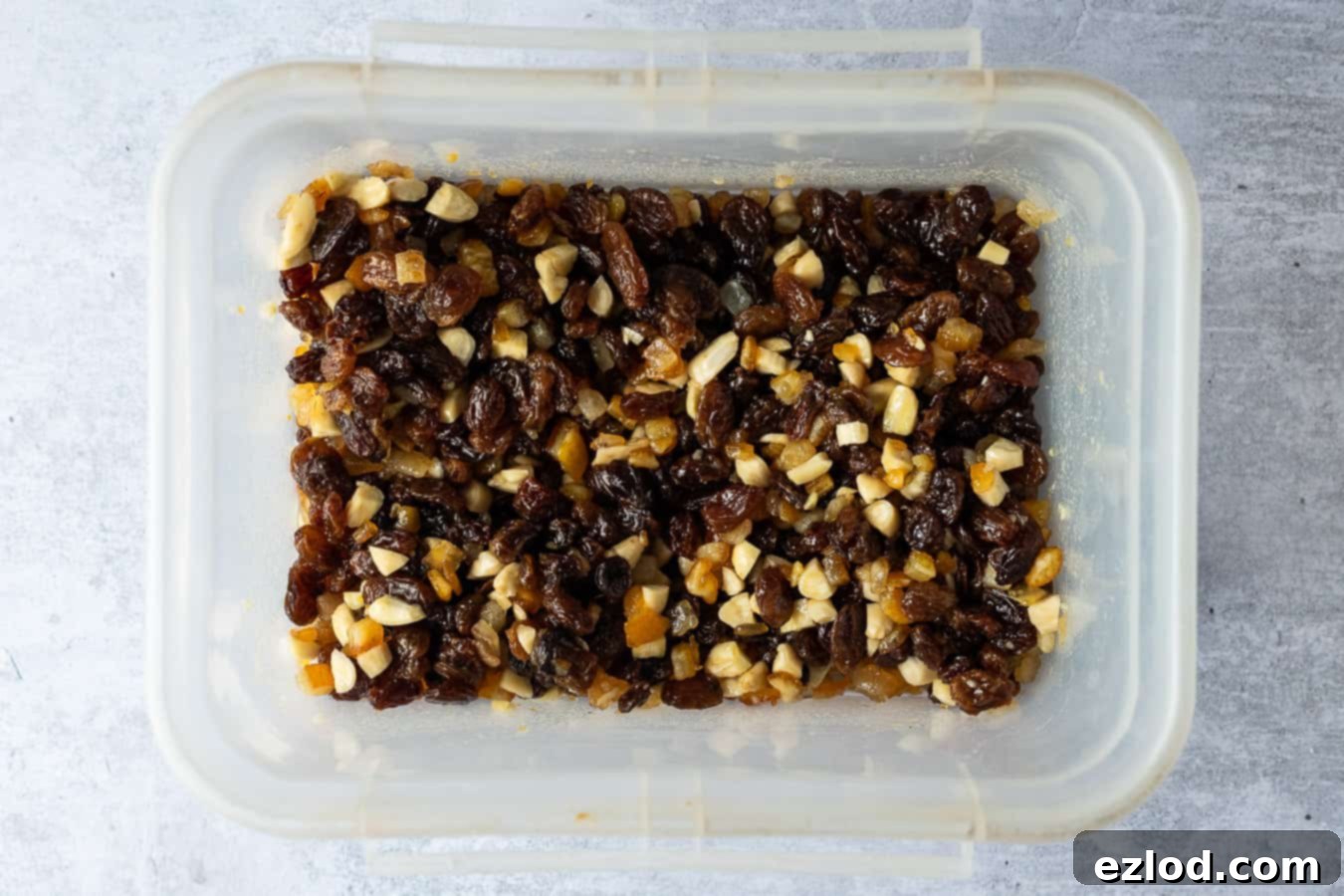
In the spacious bowl of a stand mixer, combine your dry ingredients: plain (all-purpose) flour, instant yeast, sugar, salt, and the aromatic blend of ground cinnamon, allspice, cloves, cardamom, and nutmeg. These spices are central to stollen’s festive character, so ensure they are well distributed.
Next, add the wet ingredients and fats: lukewarm unsweetened non-dairy milk (soy milk is often preferred for its neutral flavour and protein content, which aids in dough structure), vanilla and almond extracts, finely grated orange and lemon zest, and a generous amount of softened vegan block butter. The choice of vegan block butter over spreadable tub margarine is paramount here. Block butter has a higher fat content and a firmer consistency, essential for achieving the dense, rich, and tender texture characteristic of traditional stollen. I personally recommend Naturli Vegan Block for its excellent performance in enriched doughs.
Mix these ingredients until they just come together to form a rough dough. Then, increase the mixer speed and knead for approximately 10 minutes. The goal is to develop the gluten sufficiently so that the dough becomes very smooth and elastic, pulling away cleanly from the sides of the bowl. If you’re kneading by hand, prepare for a good arm workout! On an unfloured surface, knead for 10-15 minutes until the dough is smooth, pliable, and no longer sticky.
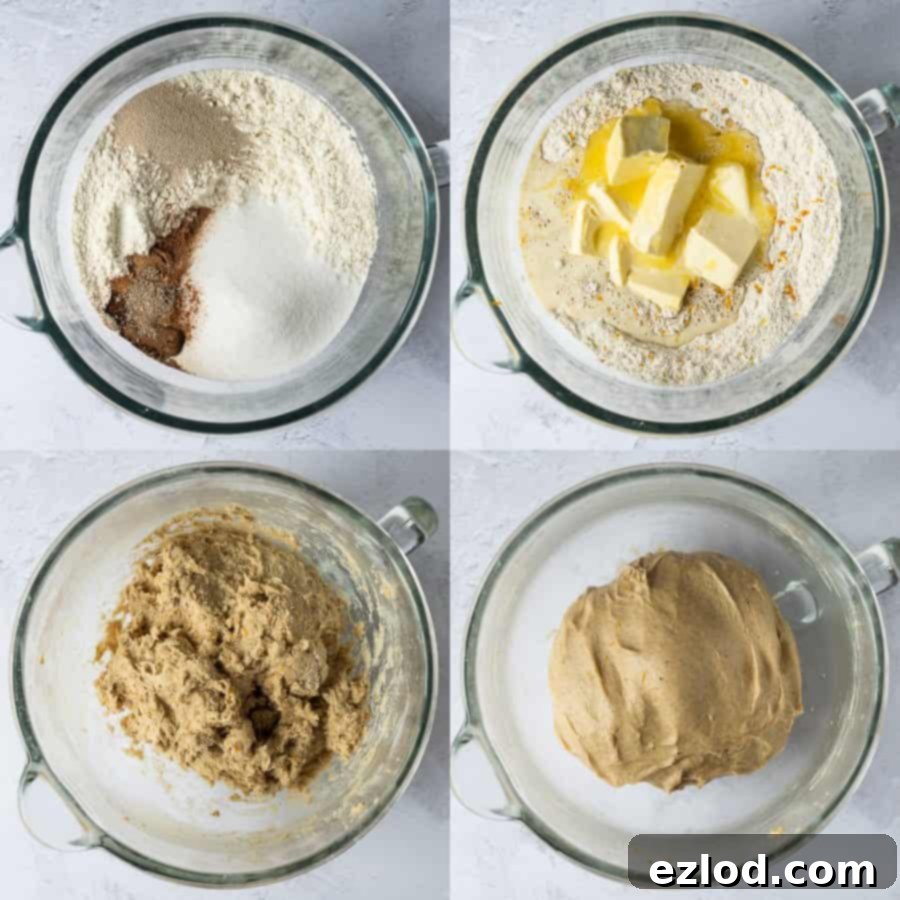
Once the dough is smooth, gently incorporate the soaked fruit and nut mixture. Knead just until the fruits and nuts are evenly distributed throughout the dough. Avoid over-kneading at this stage, as it can tear the gluten strands and toughen the bread.
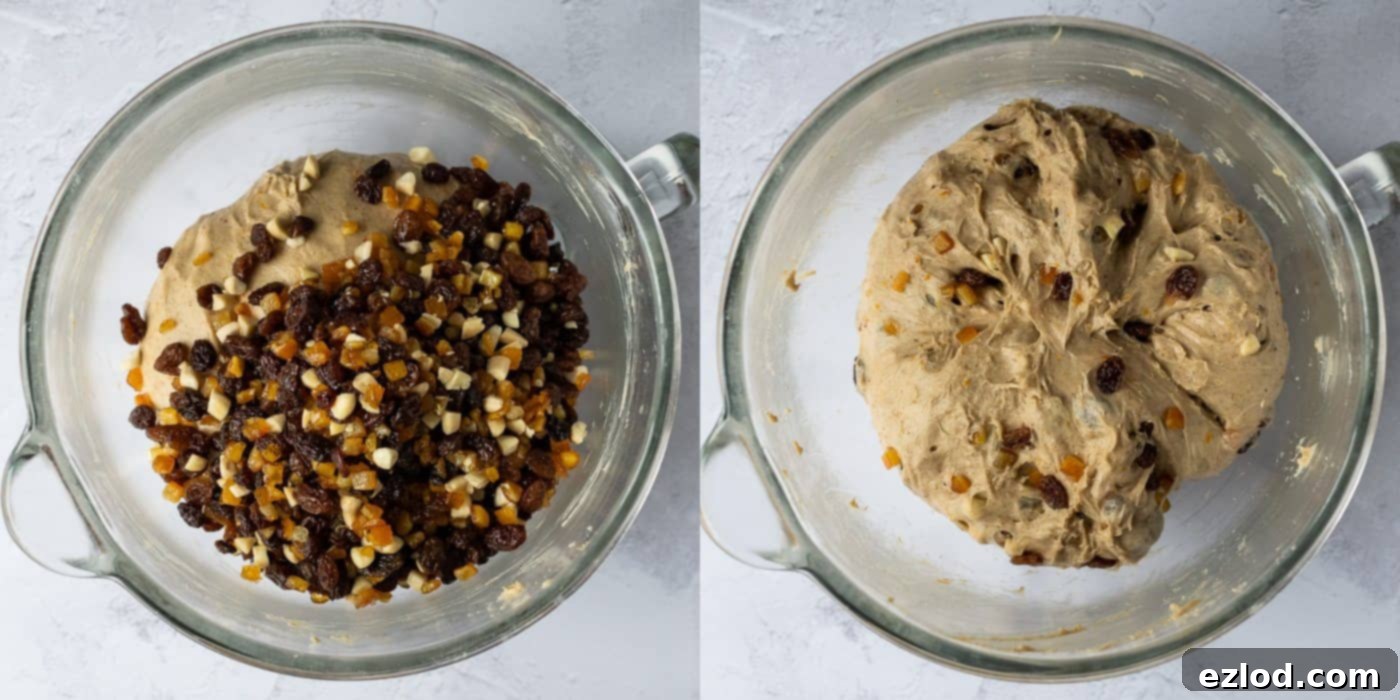
Transfer the dough to a lightly oiled bowl, cover it, and place it in a warm spot to begin its first rise. This initial bulk fermentation is lengthy, typically taking 5-8 hours, depending on the ambient temperature. The dough should almost double in size, indicating that the yeast is active and the flavours are developing. After this rise, place the covered bowl into the fridge overnight. The cold fermentation slows down the yeast activity, further enhancing the flavour and making the dough easier to handle on the third day.
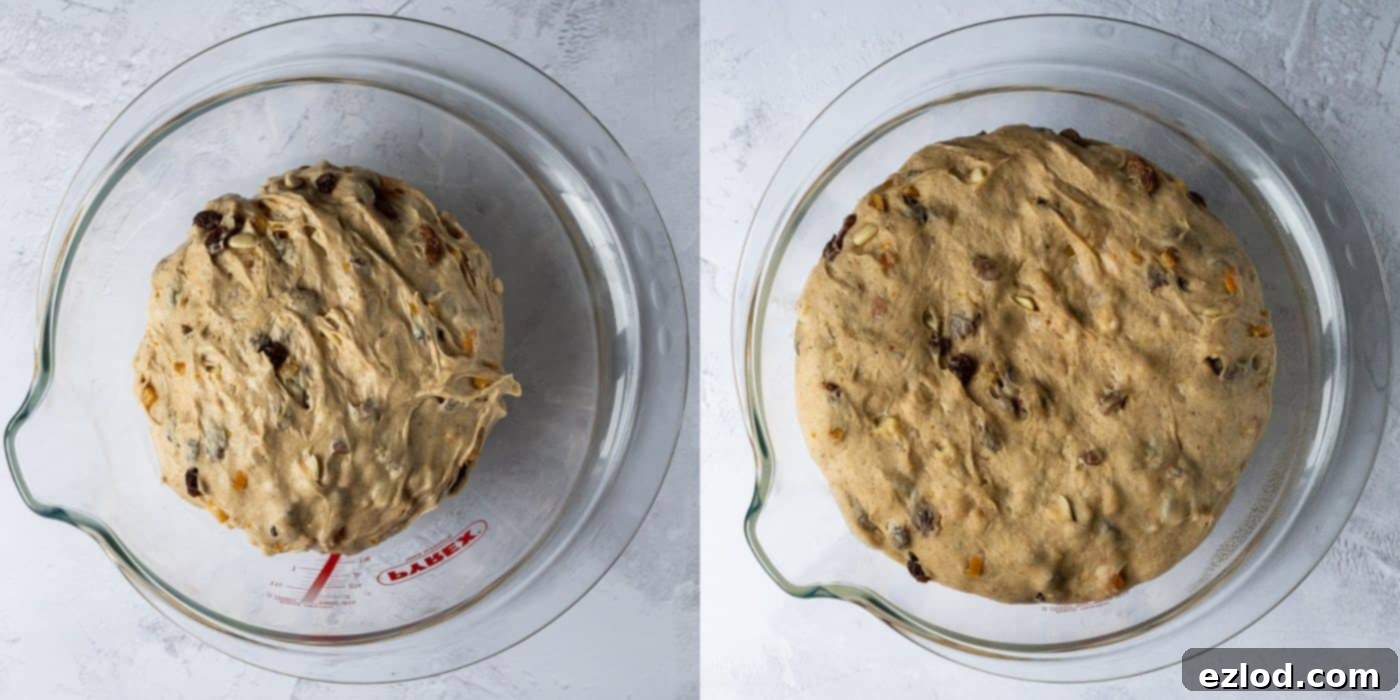
Day 3: Shaping, Second Rise, and Baking
On the morning of the third day, remove the dough from the fridge and allow it to come to room temperature for about 2 hours. This step is important for the dough to become pliable again before shaping.
Gently ‘knock back’ the dough to release the air, then divide it into two equal pieces. For precision, especially with enriched doughs, using a kitchen scale to ensure even loaves is a great practice.
On a lightly floured surface, roll out each dough portion into a rough rectangle, about 1-1.5 cm thick. Next, divide your marzipan in half and roll each half into a log slightly shorter than your dough rectangles. Position these marzipan logs just off-centre on each dough rectangle. This off-centre placement is traditional for stollen, giving it its characteristic folded shape.
Fold the smaller half of the dough over the marzipan log, then fold the larger half over the top, gently pressing to seal the edges and ends. This creates the iconic stollen shape, encasing the sweet marzipan filling within the rich dough.
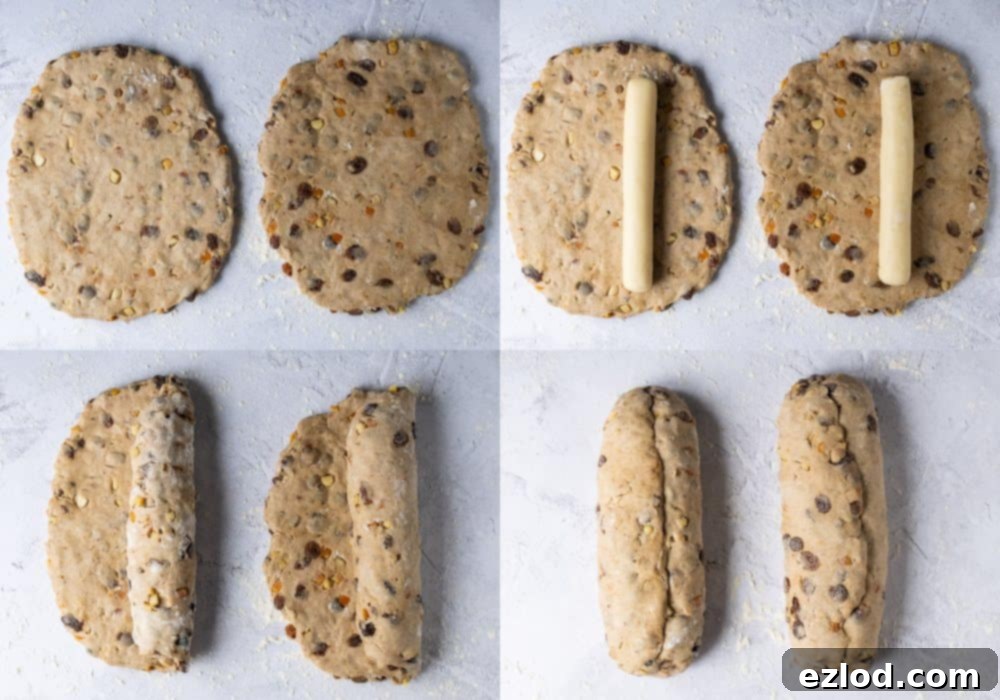
Carefully transfer the shaped loaves, well spaced apart, onto a baking sheet lined with greaseproof paper. Loosely cover them and set them aside in a warm place for their second rise. This rise will be less dramatic than the first; expect them to increase in size by about 50%, not double. This typically takes 3-4 hours. During this time, preheat your oven to 180°C (350°F / Gas Mark 4).
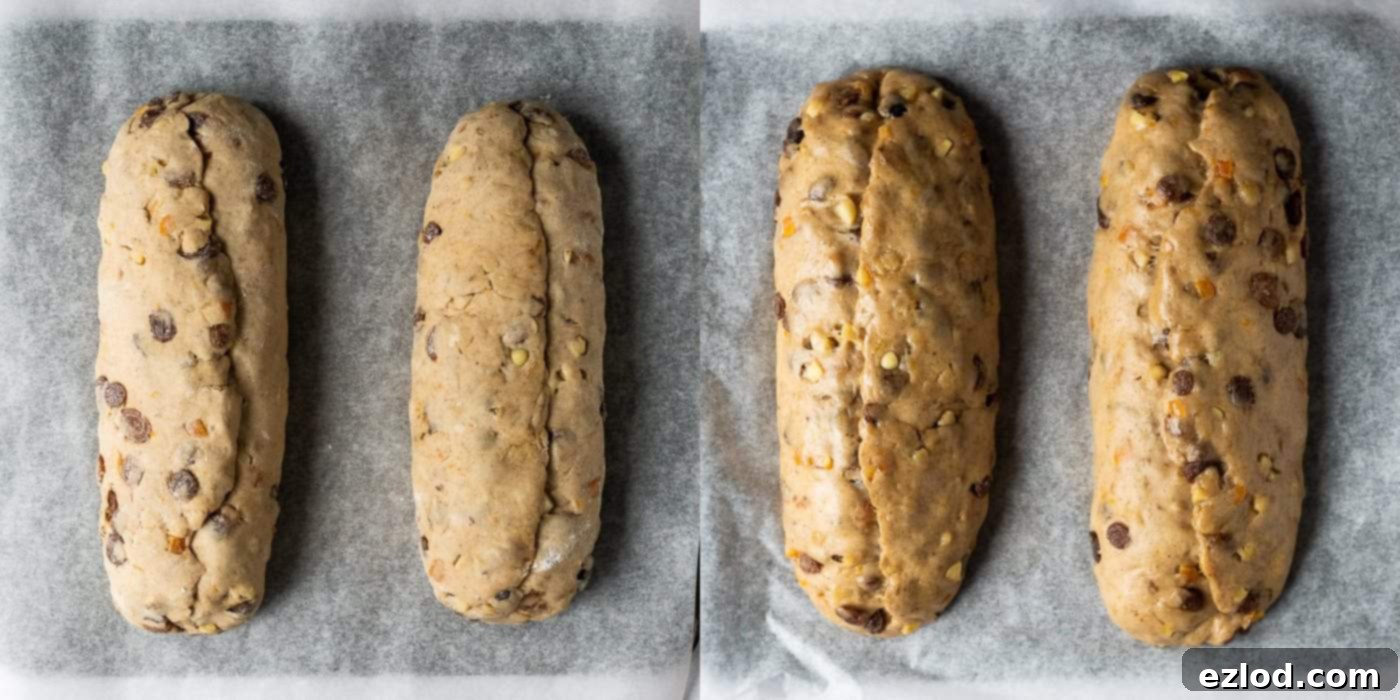
Once the stollen loaves appear puffy and have visibly increased in size, they are ready for baking. Bake them for 40-45 minutes. The most reliable way to check for doneness in bread, especially a dense loaf like stollen, is to use a probe thermometer. The internal temperature should reach at least 94°C (201°F). If the tops begin to brown too quickly, you can loosely cover them with aluminum foil to prevent burning.
Finishing Touches and Maturing
As soon as the stollen comes out of the oven, allow it to cool on the baking sheet for about 10 minutes. This is the perfect time to carefully pick off any raisins or fruit pieces that may have scorched on the surface, as these can become bitter.
While the stollen is still warm, generously brush each loaf with melted vegan butter. Let this layer of butter set, then sprinkle them with a thick, even layer of sifted icing (powdered) sugar. This butter and sugar coating is not just for aesthetics; it helps to seal in moisture, creating a protective barrier that keeps the stollen wonderfully fresh and moist for an extended period. Allow the loaves to cool completely before proceeding to wrap and store them.
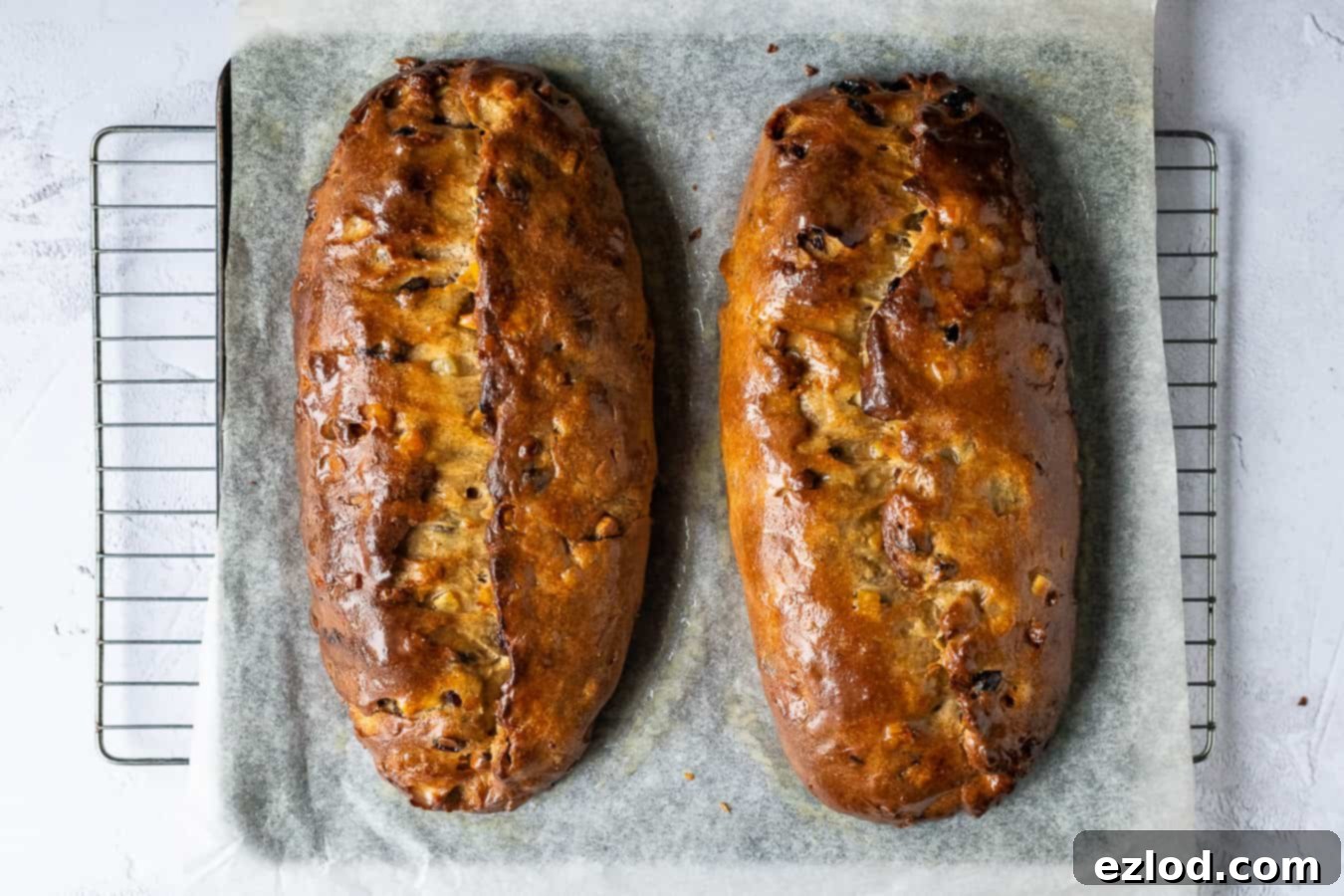
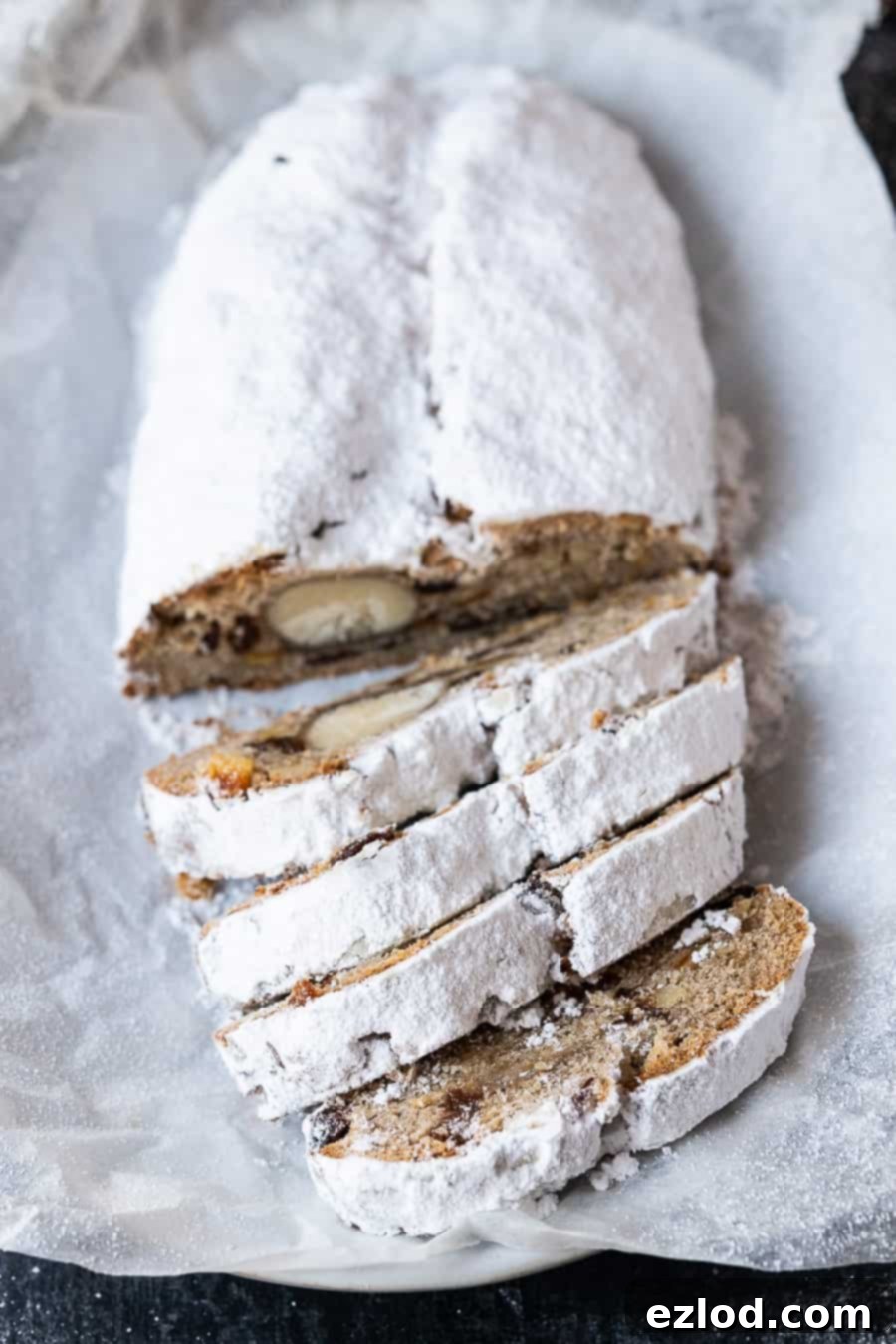
Essential Tips for Perfect Vegan Stollen
- **Fat Content is Key:** Stollen is traditionally characterized by its incredibly high fat content – roughly half the amount of fat to flour. Do not be tempted to reduce this! This high fat level is crucial not only for the rich, moist, cake-like texture but also for the bread’s impressive shelf-life. Reducing the fat will result in a dry loaf that won’t keep well.
- **Choosing the Right Flour:** While I typically opt for strong bread flour when baking most breads, for stollen, plain (all-purpose) flour is the superior choice. This is because we’re aiming for a denser, more cake-like crumb rather than the chewy, airy structure of traditional bread.
- **The Best Vegan Butter:** For optimal texture and flavour, always use a solid vegan block butter or margarine, rather than the spreadable kind found in tubs. Block butter has a higher fat content and firmer consistency, which is vital for an enriched dough like stollen. Brands like Naturli Vegan Block are excellent for this purpose.
- **Temperature for Rising:** Dough rising can be influenced by ambient temperature. If your kitchen is particularly cold and you want to gently encourage the dough’s rise, you can preheat your oven to its lowest setting for a few minutes, then switch it off. Open the oven door for about 30 seconds to release some of the excess heat, then place your covered dough bowl inside with the door slightly ajar. This creates a warm, draft-free environment ideal for fermentation.
- **Checking for Doneness:** The most accurate method to determine if your stollen is perfectly baked is to check its internal temperature using a probe thermometer. Insert the thermometer into the thickest part of the loaf; it should register at least 94°C (201°F). This ensures the stollen is cooked through without being overbaked and dry.
- **The Art of Maturing:** While you can certainly enjoy your vegan stollen fresh from the oven (after it’s completely cooled, of course!), its flavour and texture truly deepen and improve with maturity. For the best experience, wrap your cooled stollen first in baking parchment, then in tin foil, and store it in a cool, dry place for one to two weeks before slicing and serving. This allows the flavours to meld and the crumb to soften even further.
- **Gifting and Longevity:** Thanks to its high fat content and protective coating, properly wrapped stollen can last for up to six weeks. This makes it an ideal homemade gift during the Christmas holidays, offering a delicious and enduring token of festive cheer.
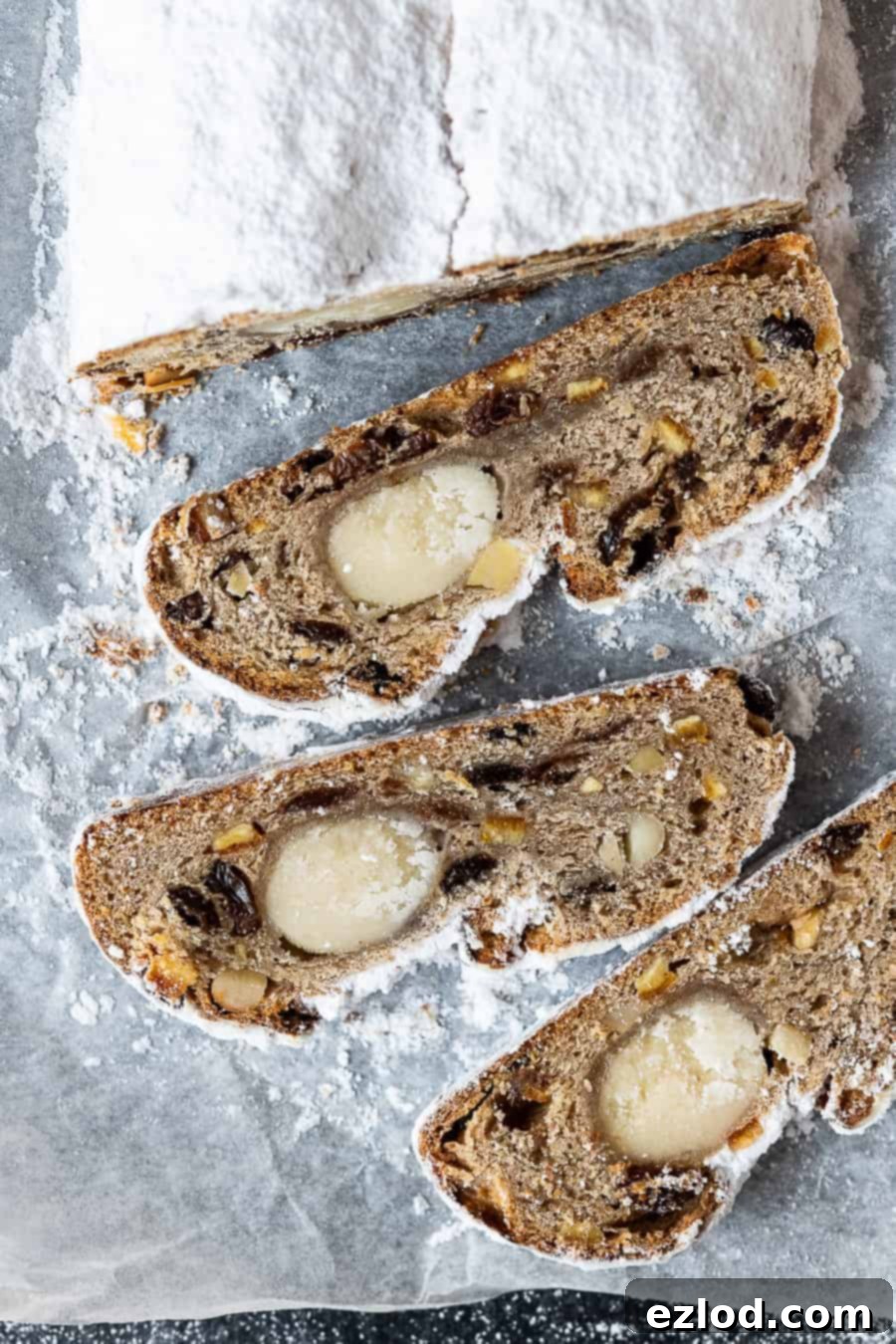
Storing Your Vegan Stollen for Optimal Freshness and Flavor
Proper storage is essential for preserving the wonderful flavour and moist texture of your homemade vegan stollen, especially if you plan to let it mature or enjoy it over several weeks. Immediately after baking and cooling for 10 minutes, brush the still-warm loaves very generously with melted vegan butter. This initial layer of fat begins the sealing process. Once the butter has set, apply a very thick, even layer of sifted icing (powdered) sugar over the entire surface of each stollen. This double coating of butter and sugar forms a protective barrier, preventing the stollen from drying out and locking in all those festive aromas and moisture. It’s a step you absolutely shouldn’t skip!
Once the loaves are completely cold to the touch – which is crucial to prevent condensation – wrap them meticulously. First, wrap each stollen tightly in a layer of baking parchment. Then, create a second, airtight layer with tin foil. Store these well-wrapped loaves in a cool, dark, and dry place. Under these conditions, your vegan stollen will keep beautifully for up to six weeks, becoming even more flavourful as it ages. This makes it an excellent candidate for advance preparation during the busy holiday season.
Can You Freeze Vegan Stollen?
Absolutely! If you’ve made more stollen than you can enjoy within its fresh storage period, or if you simply want to extend its deliciousness, vegan stollen freezes exceptionally well. Ensure the loaves are fully cooled and properly wrapped as described above (first in baking parchment, then in tin foil) to prevent freezer burn. You can then place them in an airtight freezer bag or container for an extra layer of protection. Frozen stollen can be stored for up to three months. To enjoy, simply remove it from the freezer and allow it to defrost slowly at room temperature. Once thawed, it will retain much of its original texture and flavour, making it a convenient option for holiday entertaining or a special treat anytime.
More Festive Vegan Christmas Recipes to Explore
If you’ve enjoyed baking this vegan stollen, you might be looking for more plant-based delights to adorn your holiday table or give as thoughtful gifts. The world of vegan Christmas baking is rich and diverse, offering a wealth of delicious options that prove you don’t need dairy or eggs to create truly festive and indulgent treats. Here are some more of my favourite vegan Christmas recipes that I wholeheartedly recommend:
- Vegan mince pies
- Vegan Christmas cake
- Vegan Christmas pudding
- Vegan mincemeat cake
- Vegan mulled wine brownies
- Vegan steamed chocolate pudding
- chocolate gingerbread cookies
- starry mince pie tart
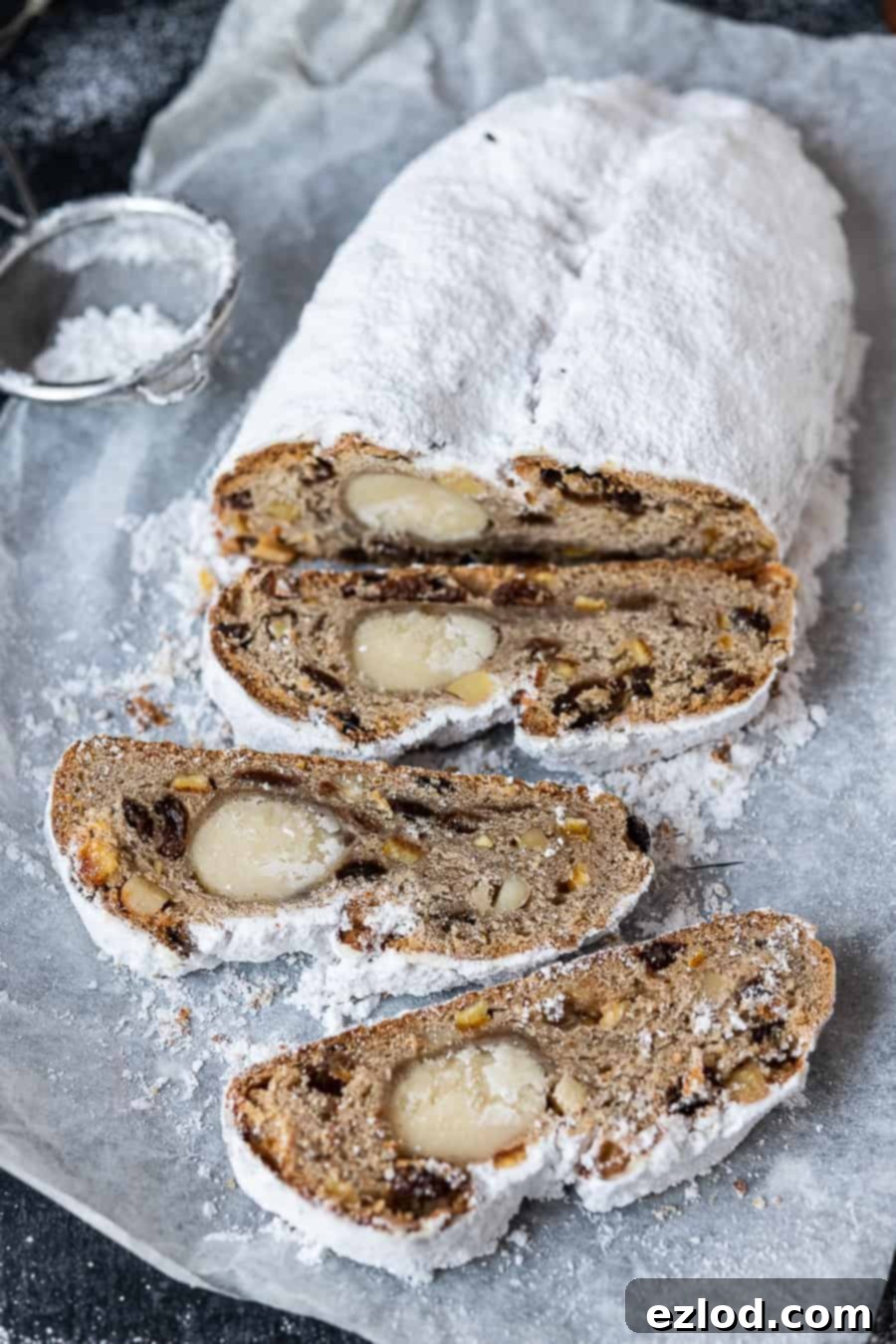
Crafting your own Vegan Stollen is more than just baking; it’s an embrace of festive tradition, a challenge rewarding patience, and a gift of exquisite flavour. Whether you enjoy it fresh, allow it to mature for weeks, or share it with loved ones, this dairy-free and eggless version of the classic German Christmas bread is sure to become a cherished part of your holiday celebrations. The rich spices, rum-soaked fruit, and sweet marzipan filling create a symphony of tastes and textures that perfectly capture the spirit of Christmas.
If you tried this recipe why not tag @domestic_gothess on Instagram and hashtag it #domesticgothess
*All images and content on Domestic Gothess are copyright protected. If you want to share this recipe then please do so by using the share buttons provided. Do not screenshot or post the recipe or content in full.*

Print
Vegan Stollen
Ingredients
Fruit Mixture:
- 250 g (9 oz) raisins
- 125 g (4 ½ oz) candied mixed peel
- 50 ml (3 Tbsp + 1 tsp) rum
- 50 g (1 ¾ oz) chopped almonds
Stollen Dough:
- 500 g (4 cups) plain (all-purpose) flour
- 10 g (2 ½ tsp) instant/fast action yeast
- 100 g (½ cup) caster/granulated sugar
- 1 tsp salt
- 1 tsp ground cinnamon
- 1 tsp ground allspice
- ½ tsp ground cardamom
- ½ tsp ground nutmeg
- ¼ tsp ground cloves
- 200 ml (½ + ⅓ cup) lukewarm unsweetened non-dairy milk (soy is best)
- 1 tsp almond extract
- 1 tsp vanilla extract
- finely grated zest of 1 orange
- finely grated zest of 1 lemon
- 250 g (9 oz) vegan block butter (I use Naturli Vegan Block) softened
- 300 g (10 ½ oz) marzipan
To Finish:
- 50 g (1 ¾ oz) vegan block butter melted
- icing (powdered) sugar for dusting
Instructions
Day 1: Fruit Preparation
-
On the evening of the first day, combine the raisins, candied mixed peel, and rum in a medium bowl. Stir thoroughly to ensure all the fruits are well coated. Cover the bowl tightly and let the mixture soak overnight at room temperature. This step infuses the fruits with rum and makes them plump and juicy.
Day 2: Dough Creation & First Rise
-
The following day, stir the chopped almonds into your rum-soaked fruit mixture.
-
In the bowl of a stand mixer, combine the plain flour, instant yeast, sugar, salt, ground cinnamon, allspice, cloves, cardamom, and nutmeg. Mix briefly to distribute the dry ingredients.
-
Add the lukewarm unsweetened non-dairy milk (soy milk is recommended), vanilla and almond extracts, finely grated orange and lemon zest, and the softened vegan block butter. Ensure the butter is truly soft for optimal incorporation.
-
Mix on a low speed until a rough dough forms, then increase to high speed and knead for about 10 minutes. The dough should become very smooth, elastic, and pull away cleanly from the sides of the bowl, indicating good gluten development.
-
If kneading by hand, work the dough on an unfloured surface for 10-15 minutes until it is smooth, stretchy, and no longer sticky.
-
Add the soaked fruit and nut mixture to the dough. Knead gently until the fruits and nuts are evenly distributed throughout the dough. Avoid over-kneading at this stage.
-
Transfer the dough to a lightly oiled bowl, cover it tightly, and place it in a warm spot for its first rise. Allow it to rise until it has almost doubled in size, which typically takes 5-8 hours depending on the warmth of your environment.
-
Once the dough has completed its first rise, place the covered bowl in the fridge overnight. This cold fermentation slows yeast activity and enhances flavour.
Day 3: Shaping, Second Rise, and Baking
-
The next day, remove the dough from the fridge and let it sit at room temperature for 2 hours to become pliable.
-
Gently ‘knock back’ the dough to release air, then divide it into two equal pieces. For best results, use a kitchen scale for accuracy.
-
On a lightly floured surface, roll each dough ball into a rough rectangle, about 1-1.5 cm thick.
-
Divide the marzipan in half and roll each half into a log, slightly shorter than your dough rectangles. Place each marzipan log just off-centre on the dough.
-
Fold the smaller half of the dough over the marzipan, then fold the other half over the top. Gently press to seal all edges and ends, forming the classic stollen shape.
-
Place the shaped stollen loaves well spaced apart on a baking sheet lined with greaseproof paper. Loosely cover them and let them rise in a warm place for 3-4 hours, until they have increased in size by approximately 50% (they will not double). Meanwhile, preheat your oven to 180°C (350°F/gas mark 4).
-
Once puffy, bake the stollen for 40-45 minutes. Use a probe thermometer to check the internal temperature, which should reach at least 94°C (201°F). If the tops brown too quickly, loosely cover them with tin foil.
-
After baking, remove the stollen from the oven and let them cool on the baking sheet for 10 minutes. Carefully pick off any burnt or bitter raisins from the surface.
-
While still warm, generously brush each stollen with the melted vegan block butter. Allow this butter layer to set completely.
-
Once the butter has set, sprinkle the stollen with a very thick layer of sifted icing (powdered) sugar. Let cool completely before wrapping and storing.
-
For the best flavour, once completely cold, wrap each stollen first in baking parchment, then in tin foil, and store in a cool, dry place for one to two weeks to mature before serving. It will keep for up to six weeks.
Notes
- For the best results, adhere strictly to the recipe, especially regarding gram measurements (using a digital scale). Cup conversions can be inaccurate for baking and may compromise the final product.
- Refer to the blog post above for detailed step-by-step photos that guide you through each stage of the process.
- The high fat content of stollen (roughly half fat to flour) is crucial for its moist, cake-like texture and excellent keeping qualities. Do not reduce the amount of fat, as this will lead to a dry bread that won’t store well.
- While bread flour is common for loaves, plain (all-purpose) flour is preferred for stollen to achieve its characteristic dense, cake-like crumb.
- Always use a solid vegan block butter or margarine for this recipe, not the spreadable kind from a tub. Block butter’s higher fat content and firmer consistency are essential for the dough’s structure and richness. Naturli Vegan Block is a highly recommended option.
- To assist dough rising on a cold day, warm your oven briefly on its lowest setting, then switch it off and leave the door ajar for 30 seconds to release excess heat. Place your covered dough bowl inside with the door slightly open to create a warm, draft-free environment.
- The most reliable way to check for bread doneness is by using a probe thermometer. Insert it into the thickest part of the stollen; the internal temperature should reach at least 94°C (201°F).
- While delicious immediately after cooling, stollen benefits greatly from maturing. For optimal flavour and texture, wrap the cooled loaves in baking parchment and tin foil, then store them in a cool, dry place for one to two weeks before slicing.
- When properly wrapped, vegan stollen can be stored for up to six weeks, making it an excellent candidate for Christmas gifts or advance preparation.
- Yes, the baked and cooled loaves can be frozen for up to three months. Ensure they are well-wrapped (baking parchment + tin foil) to prevent freezer burn. Defrost at room temperature before serving.
